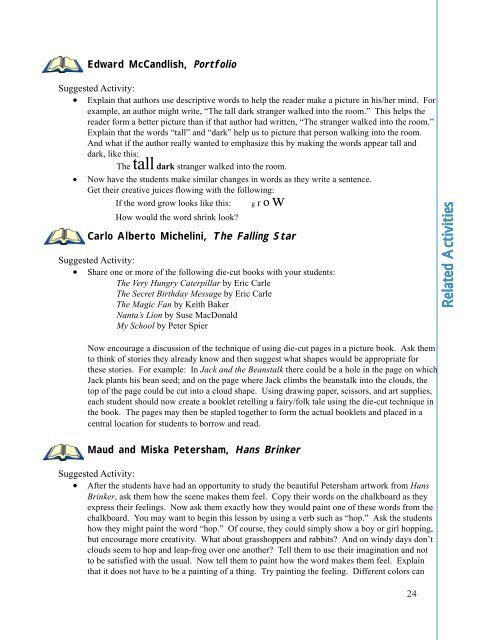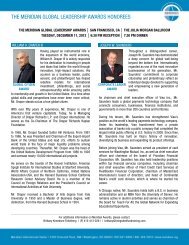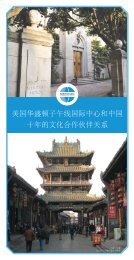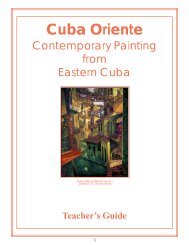Exploring the Great Outdoors - Meridian International Center
Exploring the Great Outdoors - Meridian International Center
Exploring the Great Outdoors - Meridian International Center
You also want an ePaper? Increase the reach of your titles
YUMPU automatically turns print PDFs into web optimized ePapers that Google loves.
Edward McCandlish, Portfolio<br />
Suggested Activity:<br />
• Explain that authors use descriptive words to help <strong>the</strong> reader make a picture in his/her mind. For<br />
example, an author might write, “The tall dark stranger walked into <strong>the</strong> room.” This helps <strong>the</strong><br />
reader form a better picture than if that author had written, “The stranger walked into <strong>the</strong> room.”<br />
Explain that <strong>the</strong> words “tall” and “dark” help us to picture that person walking into <strong>the</strong> room.<br />
And what if <strong>the</strong> author really wanted to emphasize this by making <strong>the</strong> words appear tall and<br />
dark, like this:<br />
The tall dark stranger walked into <strong>the</strong> room.<br />
• Now have <strong>the</strong> students make similar changes in words as <strong>the</strong>y write a sentence.<br />
Get <strong>the</strong>ir creative juices flowing with <strong>the</strong> following:<br />
If <strong>the</strong> word grow looks like this: g r o w<br />
How would <strong>the</strong> word shrink look<br />
Carlo Alberto Michelini, The Falling Star<br />
Suggested Activity:<br />
• Share one or more of <strong>the</strong> following die-cut books with your students:<br />
The Very Hungry Caterpillar by Eric Carle<br />
The Secret Birthday Message by Eric Carle<br />
The Magic Fan by Keith Baker<br />
Nanta’s Lion by Suse MacDonald<br />
My School by Peter Spier<br />
Related Activities<br />
Now encourage a discussion of <strong>the</strong> technique of using die-cut pages in a picture book. Ask <strong>the</strong>m<br />
to think of stories <strong>the</strong>y already know and <strong>the</strong>n suggest what shapes would be appropriate for<br />
<strong>the</strong>se stories. For example: In Jack and <strong>the</strong> Beanstalk <strong>the</strong>re could be a hole in <strong>the</strong> page on which<br />
Jack plants his bean seed; and on <strong>the</strong> page where Jack climbs <strong>the</strong> beanstalk into <strong>the</strong> clouds, <strong>the</strong><br />
top of <strong>the</strong> page could be cut into a cloud shape. Using drawing paper, scissors, and art supplies,<br />
each student should now create a booklet retelling a fairy/folk tale using <strong>the</strong> die-cut technique in<br />
<strong>the</strong> book. The pages may <strong>the</strong>n be stapled toge<strong>the</strong>r to form <strong>the</strong> actual booklets and placed in a<br />
central location for students to borrow and read.<br />
Maud and Miska Petersham, Hans Brinker<br />
Suggested Activity:<br />
• After <strong>the</strong> students have had an opportunity to study <strong>the</strong> beautiful Petersham artwork from Hans<br />
Brinker, ask <strong>the</strong>m how <strong>the</strong> scene makes <strong>the</strong>m feel. Copy <strong>the</strong>ir words on <strong>the</strong> chalkboard as <strong>the</strong>y<br />
express <strong>the</strong>ir feelings. Now ask <strong>the</strong>m exactly how <strong>the</strong>y would paint one of <strong>the</strong>se words from <strong>the</strong><br />
chalkboard. You may want to begin this lesson by using a verb such as “hop.” Ask <strong>the</strong> students<br />
how <strong>the</strong>y might paint <strong>the</strong> word “hop.” Of course, <strong>the</strong>y could simply show a boy or girl hopping,<br />
but encourage more creativity. What about grasshoppers and rabbits And on windy days don’t<br />
clouds seem to hop and leap-frog over one ano<strong>the</strong>r Tell <strong>the</strong>m to use <strong>the</strong>ir imagination and not<br />
to be satisfied with <strong>the</strong> usual. Now tell <strong>the</strong>m to paint how <strong>the</strong> word makes <strong>the</strong>m feel. Explain<br />
that it does not have to be a painting of a thing. Try painting <strong>the</strong> feeling. Different colors can<br />
24








